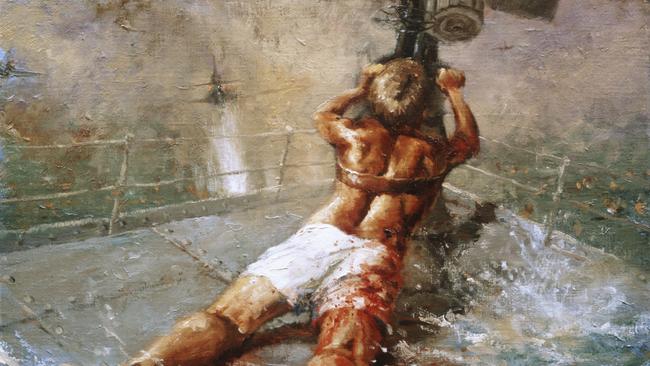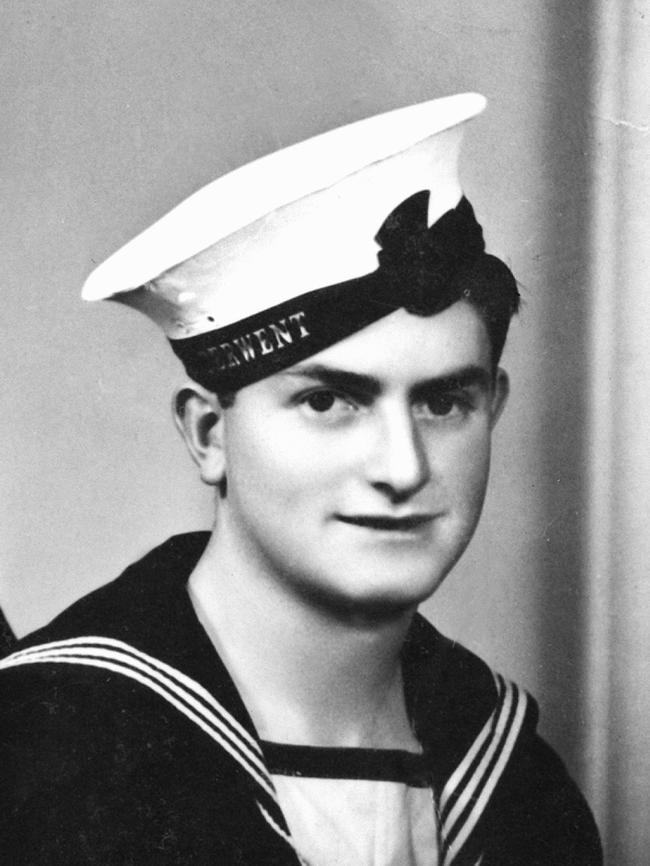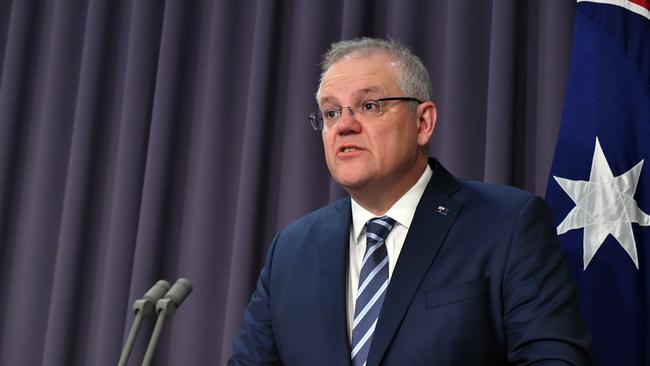The cases for and against awarding Tasmanian Teddy Sheean Victoria Cross
As the push for Tasmanian Teddy Sheean to be posthumously awarded Australia’s highest-ranking military honour continues, the Sunday Tasmanian looks at the arguments for and against awarding the Victoria Cross in a special report.
Tasmania
Don't miss out on the headlines from Tasmania. Followed categories will be added to My News.
ALMOST 80 years after Teddy Sheean’s heroism during World War II, the push for the Tasmanian to be posthumously awarded Australia’s highest-ranking military honour is showing no sign of losing momentum.
Decades of campaigning by Sheean’s family and other backers including the state’s Veterans Affairs Minister Guy Barnett has resulted in a weight of public sentiment to honour the teenage sailor with a Victoria Cross for his actions in 1942.

But despite several formal inquiries into the case, those with the power to overturn the decision have not been swayed — the most recent snub delivered last month by the Federal Government despite the Defence Honours and Awards Appeals Tribunal recommending the honour.
Following public and political pressure, Prime Minister Scott Morrison’s latest move to convene an expert panel to further review the case has given supporters new hope.
MORE: ‘WHAT MORE COULD HE HAVE DONE TO DESERVE IT?’
However, the sticking point will be whether the Federal Government can be convinced there was new and compelling evidence required to prove the case for Sheean to be honoured.
Today, the Sunday Tasmanian looks at the arguments for and against awarding the VC, including the findings of separate reviews into the case in the past decade whose individual recommendations were vehemently opposed.
THE INITIAL CASE
Sheean died on the afternoon of December 1, 1942 when the HMAS Armidale was torpedoed and sunk by Japanese forces in the Timor Sea, but the remarkable circumstances of his demise have been well documented.
The 18-year-old strapped himself to the ship’s Oerlikon anti-aircraft gun and repeatedly fired at attacking Japanese aircraft (bringing down at least one) as the vessel sunk, and is credited with saving the lives of many of his crewmates.

Of the 149 personnel on board, 49 were rescued.
Sheean, who was born in Lower Barrington and attended school in Latrobe, would have turned 19 just four weeks later.
In the aftermath, Sheean was overlooked for a Victoria Cross but was posthumously awarded a much lower-ranking Mention In Despatches.
The case in favour of Sheean being honoured with a VC includes that the initial referral to the British Admiralty was “silent” on the type of award recommended and provided little information to enable a proper assessment of the circumstances.
Mr Barnett recently said the initial process was flawed — Sheean’s name and rank was wrong, and there was inadequate information provided about his actions.
The argument that Sheean’s actions were underplayed to the British Admiralty was backed up by the chair of the DHAAT Mark Sullivan last month, who spoke out after the Federal Government knocked back the Tribunal’s recommendation to award the VC.
THE KNOCKBACK
The Sheean case was included in the Inquiry into Unresolved Recognition for Past Acts of Naval and Military Gallantry and Valour, which was known as the Valour Inquiry and ran from 2011 to 2013.
This inquiry received 21 written and 13 oral submissions about the case, including from Sheean’s nephew Garry Ivory who said the family had sought further consideration of the case since the early 1950s.
The findings showed the time from the first torpedo to the sinking of the ship was only three to four minutes.
A report from the inquiry said when the order to abandon ship was given, Sheean was on deck beside another sailor who was using a tomahawk to release the ship’s motor boat.

Sheean was trained as a loader, but also knew how to aim and fire the Oerlikon gun.
Ignoring orders to abandon ship with other crewmates, Sheean was seen returning to the gun and continued firing until he went down with the ship.
The inquiry found that despite several eyewitness accounts from shipmates backing up Sheean’s heroics, it could not recommend a VC.
It said there was “not sufficient evidence to find that there was a manifest injustice” in the initial handling of Sheean’s case and award recommendations.
“The Tribunal was also satisfied that there was no new evidence to support the reconsideration of Sheean for a VC for Australia,’’ the report said.
“The Tribunal concluded that Sheean’s actions displayed conspicuous gallantry but did not reach the particularly high standard required for recommendation for a VC.
“The Tribunal concluded there is no evidence that the recommendation to recognise Ordinary Seaman Sheean was not considered appropriately, was obstructed, or that maladministration, unfairness or injustice created a denial of process.”
The inquiry recommended no action be taken, other than suggesting the Royal Australian Navy used Sheean as the name of a major combatant vessel.
THE RECOMMENDATION
Another inquiry into the case by the Defence Honours and Awards Appeals Tribunal resulted in a far different outcome.
After two hearings in Hobart in March last year, the Tribunal recommended three months later that the original decision should be set aside and recommended to the Federal Government that Sheean be honoured with a VC.
MORE: NEPHEW OF SHEEAN DISAPPOINTED BY ROBOCALL ON VC PUSH
The tribunal heard evidence that after the abandon ship order had been given and Sheean was standing at the ship’s motor boat and turned back to the gun, he had not been wounded.
It found earlier evidence that Sheean was already wounded when he strapped himself to the gun was “improbable” — and that if he was extensively wounded, it is unlikely he would have been able to undertake the physically demanding task of firing the weapon.
The inquiry found it was more likely Sheean was wounded while returning to, or while at the Oerlikon gun — meaning he was likely not significantly injured when he made the decision to man the gun.
The Tribunal found Sheean’s action in turning back to the gun, foregoing his opportunity for survival and firing upon the enemy aircraft, constituted a “conspicuous” and “pre-eminent act of valour”.
It said he went above and beyond his duty and assumed a role that was not his.
“Ordinary Seaman Sheean’s actions disrupted and distracted the enemy aircraft from strafing and killing his defenceless shipmates in the water,’’ the report said.
“He sacrificed his life trying to save his shipmates and despite his wounds, he continued firing the gun until the ship sank and took him to his death.
“His pre-eminent act of valour and most conspicuous gallantry saved lives.
“His heroism became the standard to which the men and women of the modern Navy aspire.”
THE GOVERNMENT SNUB
The recommendation and reasoning, however, did not convince the Federal Government.
Last month, Defence Minister Linda Reynolds announced the government had rejected the Tribunal’s recommendation, sparking questions from Sheean’s family and other campaigners to ask what more the young sailor could have done to prove worthy.
A further revelation in the case happened soon after when the Chief of the Defence Force Angus Campbell wrote to the PM and Minister of Defence Personnel Darren Chester to “strongly advise” them not to seek the honour for Sheean.
General Campbell said Australia’s standing with Queen Elizabeth could be damaged if the government pushed ahead to award the VC.
He acknowledged the young sailor’s bravery but warned the request to grant him a VC could open the floodgates to a “swath of additional claims for retrospective military honours” from “all past conflicts”.
THE FRESH REVIEW
After significant backlash to the Federal Government’s rejection of the recommendation, the PM announced an independent expert panel would again look into the case.
Mr Morrison said overturning a decision relating to a Victoria Cross almost 80 years after Sheean’s actions would need compelling reasons.

The PM said the awarding of a retrospective VC would only occur in light of compelling new evidence or if evidence of “significant maladministration”.
“The Victoria Cross for Australia is our pre-eminent Australian gallantry decoration,’’ he said.
“The Government will always uphold the integrity of the Victoria Cross and everything that it stands for.
“The evidentiary standards for recommending the award of the Victoria Cross always have been, and always will be, the highest.”
The case has become increasingly politicised in recent weeks, with Federal Labor Leader Anthony Albanese saying the party would award the VC if it was elected.
Senator Jacqui Lambie has been scathing in her assessment of the Federal Government’s position, accusing it of trashing the system.
Mr Barnett, who is expected to present his case to the expert panel, has questioned what more Sheean could possibly have done to earn the honour.
The panel — led by former Defence Minister Brendan Nelson — is due to report back to the PM by July 31.


